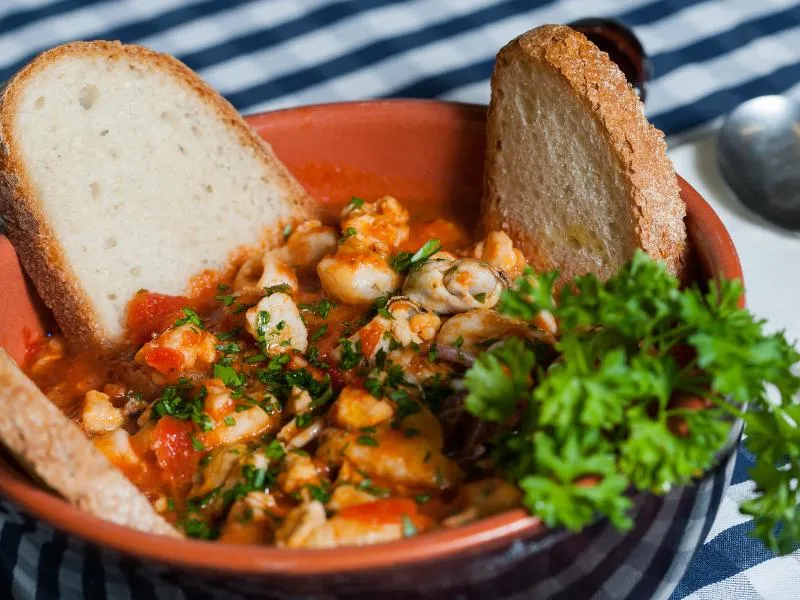Zuppa di Pesce
A flavorful Italian seafood soup with mixed fish, shellfish, and aromatics in a rich tomato broth.
👉 View Authentic Recipe 👈
About This Dish
Zuppa di Pesce, literally “fish soup,” is a coastal Italian treasure that originated as a fisherman’s meal along the shores of regions like Campania, Sicily, and Liguria. The dish exemplifies the Italian philosophy of “cucina povera” (poor kitchen), where fishermen would use the unsold catch of the day, combining various seafood in a flavorful broth. Each coastal town has its own variation, reflecting the local catch and regional preferences.
The foundation of this dish relies on an aromatic base of olive oil, garlic, and sometimes onions, built upon with white wine, fresh tomatoes, and herbs like parsley and basil. What makes Zuppa di Pesce authentic is the variety of seafood used—typically a combination of white fish, shellfish like mussels and clams, and often squid or octopus—all cooked to perfection in the fragrant broth.
Traditionally served as a primo piatto (first course) during Christmas Eve’s Feast of the Seven Fishes or for Sunday family gatherings, Zuppa di Pesce is typically accompanied by crusty bread for soaking up the flavorful broth. Regional variations include Sicily’s addition of saffron, Liguria’s use of pesto, and Campania’s spicier version with peperoncino (chili flakes).
🧑🍳 Analyzed by CucinaBot
Why This Dish Works
Zuppa di Pesce showcases the culinary principle of layered flavor development. The initial soffritto of aromatic vegetables creates a flavor foundation through slow caramelization, while the deglazing with wine adds acidity and depth. The different types of seafood release their natural gelatin and umami compounds at varying cooking times, creating a broth with remarkable complexity. The final addition of fresh herbs provides aromatic top notes that balance the deep, savory base.
Key Success Factors
- Cooking Sequence: Adding seafood in the correct order based on cooking time (firm fish first, delicate shellfish last) prevents overcooking
- Freshness: Using impeccably fresh seafood is non-negotiable—it’s the foundation of the dish’s flavor
- Restraint with Tomato: The tomato should complement, not overwhelm, the seafood flavors
- Proper Seasoning: Careful with salt initially as shellfish will release natural brininess as they cook
Common Pitfalls
Many non-authentic recipes overcomplicate Zuppa di Pesce with unnecessary ingredients or treat it like a tomato-heavy American fish stew. The most common mistake is overcooking the seafood by adding all types simultaneously, resulting in rubbery shellfish and disintegrated fish fillets. Another frequent error is aggressive boiling rather than the gentle simmer required to preserve the texture and flavor of delicate seafood.
How to Judge Authenticity
When reviewing recipes, look for these markers of authenticity:
- Begins with a proper soffritto using olive oil, garlic, and minimal aromatics
- Uses at least 3-4 different types of seafood, including both fish and shellfish
- Contains a relatively light tomato presence (not a heavy sauce)
- Specifies adding seafood in sequential order based on cooking times
- Finishes with fresh herbs and is served with crusty bread, not over pasta